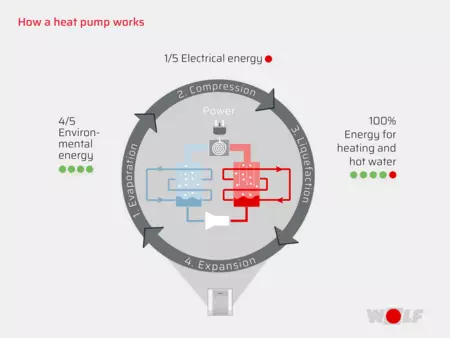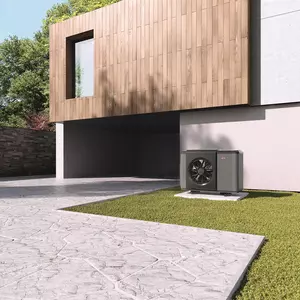
Compare heat pumps
Find the right heat pump for you
Heat pumps are an efficient way to heat new and existing buildings - particularly in the right conditions. Which type of heat pump is the best match for your building will depend on a number of different factors. That’s why comparing different heat pumps before you make a decision is so important.
Heat pumps can draw heat from different sources - like the air, ground or groundwater. Different types will vary in terms of how expensive and easy to install they are. You should choose a heat pump which suits your living situation. Here are some of the most important factors to consider:
- The condition of the building (including how well insulated the building is)
- The size of your property and the amount of space the heat pump will occupy
- The amount of living space that you will be heating with the heat pump
- The current heating system and its condition
Tip: WOLF supplies sophisticated heat pump and heating system solutions to meet your needs.
All heat pumps work in the same way. The system uses a heat exchanger to transfer thermal energy from a source (air, water, or the ground) to a refrigerant. This refrigerant condenses and circulates to a second heat exchanger, where the energy is transferred to the actual heating water circuit. This process causes the refrigerant to turn back into a liquid and flow back to the first heat exchanger, where the cycle begins again.
Taking thermal energy from a source is free. The unit needs electricity to run, but only a relatively small amount. Connecting a heat pump to a photovoltaic system will reduce your costs even further, while also covering at least some of the electricity required by the heat pump. Utility companies also provide special cheap rates specifically for running heat pumps.

All heat pump systems function like a ‘reverse’ refrigerator. They draw freely available thermal energy out of the air, water or ground and feed that energy into your heating system. However, they do vary in terms of how much they cost and their requirements.
The following types of heat pump are available for residential use:
- Air-to-water heat pump (air source heat pump)
- Brine-to-water heat pump (geothermal heat pump)
- Water-to-water heat pump (ground water heat pump)
- Air-to-air heat pump
The convention for heat pumps is for the source of the thermal energy to come first (e.g. air, ground, water), followed by the medium (water) used to transfer heat. In a residential setting, this is usually the heating water which circulates in your radiators or underfloor heating to keep your living space warm.
Other more specialised types of heat pump are also available. These include air-to-air heat pumps, which are generally less efficient and really only suitable for quite specific situations - like passive houses which do not have a traditional heating system.
A DHW heat pump also draws in thermal energy from the air and can be useful as a backup for your central heating system. These systems are usually able to handle DHW heating duties.
Heat pumps in comparison
Our comparison looks at the three most popular types of heat pump. Which system is right for you will depend on your living situation and the space you have available.
The air-to-water heat pump
Air-to-water heat pumps are the most popular type. Because they take thermal energy directly from the air, you don’t need to make room for a borehole, collector or probe - making this type the easiest to install. Air-to-water heat pumps can be installed anywhere you like, as long as you are in compliance with local planning regulations (such as the amount of space you need to leave between the unit and your neighbour).
Features of air-to-water heat pumps
The brine-to-water heat pump
Past a certain depth, the temperature of the soil remains fairly constant all year round. A brine-to-water heat pump, also called a ground source heat pump, uses probes or geothermal collectors to draw heat out of the ground.
Features of brine-to-water heat pumps
The water-to-water heat pump
Water-to-water heat pumps also use the consistent temperatures which you find at a depth of around 10 metres. Unlike ground source heat pumps, these systems draw heat from ground water. A supply well channels the ground water to the heat exchanger, which transfers thermal energy to the refrigerant and the heating circuit. The cooled groundwater then drains back into the soil through a soakaway well.
Features of water-to-water heat pumps
Summary
While air-to-water heat pumps offer a high degree of flexibility, geothermal heat pumps and water-to-water heat pumps can only be installed indoors. You will also need to factor in the cost of installing the components required by the heat pump (e.g. collectors, geothermal probes or boreholes). Air-to-water heat pumps are the perfect choice if you do not have enough room for a system indoors or if you prioritise flexibility over other factors.
04. Where can I install a heat pump?
Split design
If you choose an air-to-water heat pump, it is possible to split the components between a space-saving indoor module and an outdoor module. This approach reduces noise levels by keeping the noisy components outside of the building. The indoor module is housed in the basement to protect it against the elements. Shorter connecting lines to the heating system also help to reduce heat losses.
Outdoor installation
Air source heat pumps are usually installed outdoors. Monoblock heat pumps are particularly popular because all of the technical components like the compressor and condenser are housed in a compact outdoor unit. The thermal storage cylinder is kept indoors.
One significant advantage of these systems is that they are very compact. In other words, you only need a small amount of space in the house itself to connect the heat pump to the heating system. This makes monoblock models particularly suitable for installation in existing buildings or new buildings with limited space.
Even though modern high-quality units are pretty quiet, you should install a heat pump outdoors some distance away from your wall. Don’t make that distance too big though - the longer the pipes running to the heating system, the greater the heat loss.Indoor installation
If a heat pump is installed indoors, all of the technical components of the heat pump will be located inside your house. The majority of brine-to-water heat pumps and water-to-water heat pumps are installed indoors, with their collectors, probes or wells located outdoors. Air source heat pumps provide a high degree of flexibility, as they can be installed outdoors, inside or in a split design. If an air source heat pump is installed indoors, the air is drawn in from the outside through ducts.
Indoor units take up space in the basement. If you are replacing an old heating system, the vacant space would be a good place to install it. You also need to be aware that noise generated by the heat pump could be transmitted to adjoining rooms through the walls.
Tip: The WOLF CHA monoblock heat pump is compact, efficient and powerful This highly efficient air-to-water heat pump can also be used to heat existing buildings. Like all WOLF appliances, it comes with a 5-year warranty and is 100% “Made in Germany“.
As noted above, official permits are required for systems that require boreholes to be made in the ground, i.e. geothermal and ground water heat pumps. Depending on the depth of the borehole and where you live, you may only need to inform the local water authority. Additional permits are required for boreholes deeper than 100 metres in many federal states.
Additional permits are not normally required for the installation of geothermal collectors, as these are installed close to the surface. Air source heat pumps are the least complicated option as you can install them anywhere in Germany without a permit.

Top advice from WOLF
If you are looking for an efficient heat pump for your existing building or a new build, you should seek in-depth advice. Correct dimensioning and careful planning are crucial for efficient heating. The experts at WOLF will be happy to help you.
If you are planning a new building, you can use any type of heat pump as long as you make sure that you are in compliance with the Building Energy Act (GEG). However, heat pumps are also an efficient option for both existing buildings and older buildings. Air-to-water heat pumps are often used in these situations due to their compact dimensions and the fact that it is easier to take thermal energy from the air than from ground water or the soil.
The higher the temperature of the heat source and the lower the flow temperature in the heating system, the more efficiently a heat pump will operate. This gives users of radiant heating systems an advantage due to their low flow temperatures. However, efficient solutions are also available for other heating systems, such as radiators.
Once the structural requirements have been established, the next thing to address is efficiency. The efficiency of a heat pump can be measured based on its coefficient of performance (COP), the seasonal performance factor (SPF) and how much energy it needs to run. While the SPF provides an indication of the efficiency of a heat pump throughout the year, the COP indicates how much electricity is required to convert ambient heat into thermal energy. However, the COP is only of limited significance as it only takes theoretical values into account and does not provide a realistic impression of the ongoing operation of the heat pump. Because of this, your decision should always look at the SPF in combination with the coefficient of performance.
What can we tell from the SPF?
A heat pump's SPF indicates how much heat in kilowatt-hours (kWh) the heat pump can generate with 1 kWh of electricity. Water-to-water heat pumps are the most efficient, with an SPF of 5, followed by brine-to-water heat pumps with an SPF of 3.9 and air-to-water heat pumps with an SPF of 2.9. However, air-to-water heat pumps can be significantly more efficient than this figure depending on the manufacturer.
A cooling function is a particularly convenient feature. A heat pump with this feature can run in reverse and extract heat from indoors via the heating system in order to transfer it to the outside. Only a circulation pump is needed for this function, which uses much less electricity than conventional air conditioners. You will also need a radiant heating system, such as underfloor heating. All types of heat pump can be used for cooling, and this feature is usually included as standard.
All modern types of heat pump provide climate-friendly, reliable and energy-efficient heating. Air source heat pumps are the easiest to install and offer the most advantages overall. However, depending on your circumstances, you might find other types to be a viable option. Regardless of the type you choose, we recommend connecting it up to your photovoltaic system to cover the electricity required by the unit.
Getting professional advice from a heating engineer on site is always the best choice. They can draw on their expertise to recommend the right heat pump for your building. You can use our website to find a qualified contractor in your area.


